|
|
Orville

|
|
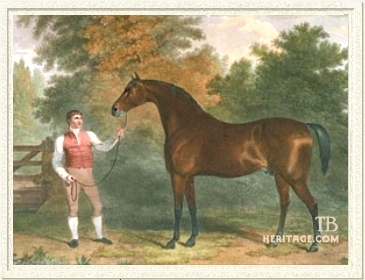 |
|
|
Orville was a big, plain-headed racehorse of great stamina and exceptional durability, considered one of the great four-mile horses of his era. He was a successful sire of classic winners, and several of his sons also got one or more classic winning colts, but this branch of the King Fergus sire line petered out when his many good running grandsons failed to get sons who could perpetuate the line successfully. Still, his name is well-represented in pedigrees, through his daughters, and the daughters and grandaughters of his sons and grandsons.
|
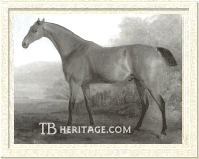
Beningbrough
| |
His sire, Beningbrough, was by King Fergus (by Eclipse) and out of a mare by Herod, whose dam, Pyrrha, was by Matchem, thereby combining the blood of the three great 18th century sires within three generations. Bred by John Hutchinson at his Shipton, Yorkshire, stud, Beningbrough was a big horse of great endurance and courage, who passed these traits on to Orville. Beningbrough ran for Hutchinson and then Sir Charles Turner for four years, and exhibited such feats of stamina and class as winning the 1794 Doncaster St. Leger (then run over two miles), and the following day, winning the then four-mile Doncaster Cup; this ability to win two important distance races on successive days was repeated in 1795, when he won a four-mile match at York, and the next day won the Doncaster Stakes.
|
Re-purchased by Hutchinson, Beningbrough first stood at stud at Shipton for a fee of 6 guineas. Orville was his first offspring to win, and after Orville, his stud fee was raised to 25 guineas. His other good son was Doncaster Cup winner Scud, who got two Derby winners -- Sam and Sailor -- and Shoveler, an Oaks winner. Beningbrough himself sired two Oaks winners, Briseis and Oriana, and, in the breeding shed, four of his daughters produced classic winners. Despite the success of Orville and Scud at stud, it was another King Fergus son, Hambletonian, who was destined to continue the sire line through his grandson, Blacklock.
Orville's dam, Evelina, by the great sire Highflyer, was the product of several generations of breeding at Wentworth Woodhouse, the family estate of the Lords Rockingham and their successors, the Lords Fitzwilliam, which was situated just a few miles from Doncaster. Born in 1791, Evelina had a career on the turf, running four mile races against such horses as the good four-mile, cup-winning filly Eliza. In 1798 Evelina dropped her first foal at Wentworth Woodhouse, a filly by Volunteer. In addition to Orville, she produced the good runners Capsicum (1805, by Sir Peter), Cervantes (1806, by Don Quixote), and the in-bred Paulowitz (1813, by Sir Paul, grandsire of Ion and a fairly long-lived sire line that included Wild Dayrell), the latter two later good sires. She also bred two daughters, Louisa (1800, by Ormond) and Orville's sister, Orvillina (1804), both of whom were tail-female ancestresses of classic winners.
Evelina's dam was the Tantrum daughter Termagant (1772), bred at Wentworth Woodhouse by the Marquis of Rockingham, and a great producer for William Wentworth-Fitzwilliam, (2nd) Earl Fitzwilliam in England (4th Earl in Ireland). In addition to Evelina, she produced Ceclia (1793 by Sir Peter), a fair race mare and dam of Doncaster Cup winner Whitenose (1806, by Don Quixote). Another Termagant daughter was St. Leger winner Pewett (1786 by Tandem), in turn a great producer at Wentworth Woodhouse, dam of Sir Paul (1802, sire of Paulowitz); the good racer Lapwing (1797); St. Leger winner Paulina, from whom descended a number of classic winners; Clinkerina (1812, by Clinker), the dam of the huge Humphrey Clinker (1822, by Comus), who was the sire of the influential Melbourne. Termagant's dam, Cantatrice (by Sampson), was also bred at Wentworth Woodhouse.
Orville was Evelina's second foal, born in 1799, and he inherited her "deep saucer eyes," typical of Highflyer offspring. He grew to over 16 hands, a bay, with a somewhat unrefined head and one front leg that was over in the knee. He had a powerful, stocky build, The Druid noting "...there was a great deal of the coach horse about him." He would pass on the head, front legs, and coach-horse look to a number of his offspring. He ran in the Fitzwilliam green colors until his sale, near the end of 1804, to George, the Prince of Wales.
Orville on the Turf
Orville was an extremely stout -- his "lungs and courage were quite inexhaustible" -- and durable runner, and as far as his frequent jockey, William Edwards, was concerned, he was the "best for all distances." However, he was a difficult ride, "...so inanimate and dead-skinned that nothing but a whip that would curl well round him could make any impression whatsoever." Lightly-weighted for the Doncaster Cup, on the day following his 1802 St. Leger win, William Edwards, then a "feather" lad, was put up on him, and in reply to his fearful fretting that Orville would run away with him and his begging to be allowed to ride the horse with a curb bit, Orville's trainer, Christopher Scaife, knowing "the colt to be such a slug," laconically replied, "the further he runs away, the further he'll beat 'em."
Orville debuted at York in a sweep for juveniles, running fourth to L'Orient, and followed this by a win in a juvenile sweep at Doncaster, even weights, beating four others.
He did not run again until August of his three-year-old year, when he ran second of four in a 50 guineas sweep for his age group at York, beaten by Sir John. His next race was another sweep at the same meeting, again running second, this time to Peter, another son of Beningbrough. His next race was the St. Leger, which Fitzwilliam had won once before, with Pewett (beneficiary of a disqualification), the half-sister of Orville's dam, in 1789. But Fitzwilliam, whose elaborate coach with matching Wentworth Woodhouse-bred coach horses and numerous livery-clad outriders and assorted tenants led the procession which opened the Doncaster fall meeting, had failed to win in successive years with numerous youngsters. Orville started fourth-favorite in a field of seven, with another Fitzwilliam colt, Sparrowhawk (by Buzzard, from Orville's granddam, Termagant) second-favorite. Orville took the lead at the start, and was never headed, winning easily, with Pipylin second and Sparrowhawk third; his jockey in that race, John Singleton, jr., died three months later racing at Newmarket.
The next day was the Doncaster Cup, with the lad Edwards aboard and his fears of Orville running away with him were justified, when, sandwiched between John Jackson, on Alonzo, and John Shepherd, on Sir Solomon, they each applied "sly" strokes of the whip to Orville, "most effectually waking up Orville for him." Edwards, shouting "I'll tell the Jockey Club of you," and the excited Orville were kneed onto the rails by Shepherd. Despite this mishap, Orville ran second to Alonzo, beating nine others; the time for this race, over four miles (less 408 yards), was a very brisk 7 minutes, 8 seconds.
Orville ran three times at age four, in 1803, placing second to Lenox in a sweep at York Spring, and second to Duxbury in a sweep at York August, and unplaced in his last start of the year. The following year he won a race over two miles at York Spring, beating Ormond. In August of that year he ran last in a sweep at York, won by Haphazard, but at Doncaster, in the fall, he won a sweep beating Pipylin, and a 200 guineas match against Stockton over four miles. After Doncaster, he was sold to the Prince of Wales (future George IV), and it was in the Prince's colors that he ran at Newmarket, in October, placing second to the 1801 Derby and Oaks winner, Eleanor, in a four mile sweep.
At age six, there was a decided shift in venues for Orville; from running at York and Doncaster, the home turf of his owner-breeder, Lord Fitzwilliam, he now raced in the royal colors, under the management of Delme Radcliffe, at Newmarket, and at Brighton and Lewes, both made fashionable by the fast set that surrounded the Prince of Wales. In 1805, Orville began at Brighton, where he ran last in the Somerset Stakes, but was awarded first, being the only horse of the four that ran (Walton, Houghton Lass, Enterprise being the others) that ran the full course. His next race, also at Brighton, was a win over four miles in the Prince's Gold Cup. The Prince was no doubt exceptionally gay after this three-day Brighton meeting; in addition to Orville's two wins, he won four other races with four other horses in his ownership. Orville went on to Lewes, where he won the four mile King's Plate, beating Rolla in two heats. At the same meeting, he ran a four-mile trial against Haphazard at four in the morning, beating him so soundly that Haphazard's jockey, the notable Sam Chifney reported "so decidedly to his horse's loss of form, that he started in public no more." The afternoon of the same day as his pre-dawn trial, he ran a "most punishing race" over three miles, beating the good Sir Peter son, Walton. He ran once more that year, without success.
In 1806, now age seven, Orville won a sweep over the Beacon Course at Newmarket Second Spring, beating the aged Quiz and two others. He was taken on to Lewes, wher he received a forfeit from Houghton Lass, and at the same meeting enjoyed a walk-over for 90 guineas. In October he beat the good mare Parasol, and three other good runners, 1805 St. Leger winner Stavely, Houghton Lass, and Henry, over the Beacon Course at Newmarket First October. At Newmarket Second October he won a 200 guineas match against the 1804 St. Leger winner Sancho, who broke down during the running. Orville ran one more race that year, but did not place.
In his last season on the turf, at age eight, he won all seven races he entered. These included a handicap at Newmarket, beating Pelisse; a walk-over at Brighton for 125 guineas; a match against Pelisse at Lewes; a race at Lewes, beating Cerberus, and the Ladies' Plate at Lewes, beating Brighton; a 105 guineas race over Newmarket's Beacon Course, beating Canopus (age four), and a 350 guineas race over the Beacon Course at Newmarket Second Cotober, beating the aged Parasol.
Orville in the Stud
Orville began his stud career at the Prince of Wales' stud, Six Mile Cottage, near Newmarket, for a fee of 15 guineas. After the Prince disposed of his breeding stock, in 1808-9, Orville was moved to Thomas Kirby's stable at Walmsgate Bar, York, where he stood for 20 guineas. He got a number of successful youngsters, including five classic winners, and led the sire's list in Great Britain twice, in 1817, the year of Ebor's St. Leger win, and in 1823, when Emililus won the Derby in an undefeated season. Emilius was his best son on the turf, later two-time leading sire who got eight classic winners, four of them colts and one of these, Priam, a top sire of racehorses. Another Orville son, Muley, was the sire of three classic winners, two of them colts. And another son, Andrew, got the dual-classic winner Cadland. With a wealth of good running grandsons, it appeared the King Fergus sire line would continue through Orville, but none of these horses were able to get a son who could carry on this branch. Still, Orville is well-represented in thoroughbred bloodlines through his daughters, and the daughters and grandaughters of his sons.
Orville had a significant influence on American bloodstock through the daughters of his sons, Priam (by Emilius) and Leviathan (by Muley), who, between them, led the sire's list in the United States ten times, dominating the late 1830s and 1840s. His own daughters, and the daughters of his English sons also exerted a big influence on the breed: Muley was dam's sire of the enormously influential Pocahontas; Master Henry was dam's sire of the great racer and stallion Touchstone.
Many of Orville's progeny were large, brown or dark bay horses, and not a few had "rather cart-horse heads. One son, Don Juan (1814, from Peterea by Sir Peter), actually became the sire of coveted Yorkshire coach horses when he went to stud near Catterick Bridge, covering Cleveland Bay mares. After a successful stud career and a long life, Orville was shot in November, 1826, age 27.
|
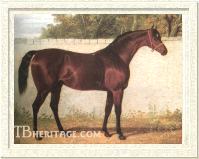
Emilius
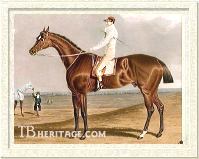
Ebor
| |
EMILIUS (1820) was a dark bay horse out of Emily, by Stamford. He was bred by Colonel John Udney, who was a member of the Jockey Club and racehorse owner in the first decades of the 19th century. Emilius inherited a somewhat more refined version of his sire's plain head, and was a muscular horse with an arching neck, a great chest and forearms, and short legs. He looked, The Druid, said, "quite as much a hunter as a blood horse." His dam, Emily, ran and placed in handicaps at Newmarket for Udney before being retired to the breeding shed. He started his career at age three, running undefeated in the Riddlesworth Stakes, a sweepstakes at Newmarket First Spring, the Epsom Derby, a 500 guineas race at Ascot, the Grand Duke Michael Stakes at Newmarket First October, and a stakes race worth 800 guineas at Newmarket Second October. He also took a walk over for the Dinner Stakes at Newmarket First Spring. At age four he won a 500 guineas match at Newmarket, but lost two other matches and ran last in Newmarket's Audley End Stakes, and was retired to stud.
He was sold for 1800 guineas to Thomas Thornhill, squire of Riddlesworth in Norfolk, who was partial to Beningbrough stock, and had won the Derby with Scud sons Sam (1820) and Sailor (1823). At Riddlesworth Emilius sired eight classic winners, and was twice leading sire in England. His son, Priam, was leading sire twice in England before his export to the U.S., where he was four-times leading sire from his new home at Belle Meade Stud, Tennessee, and another son, Sovereign, also sent to the U.S., was the sire of the great race mare, Prioress.
|
EBOR (1814) was a bay horse out of Constantia, by Walnut. He was bred by Henry Peirse at Rand Grande, his Bedale, Yorkshire, stud, and retired to stud there after his career on the turf was over, to stand at 10 guineas. His female family had been in the Peirse stud since the 1780s, when Peirse secured the Herod daughter, Doncaster Cup winner Tuberose, who was the fourth dam of Ebor in tail-female descent. Many great horses descend in tail-female from Tuberose, the principal conduit of Family 19.
EBOR'S big win was the 1817 Doncaster St. Leger, in which, going off at odds of 100 to 4, he beat the mighty Blacklock, a defeat attributed to Blacklock's trainer by some, and by the trainer to the jockey. Ebor's other wins were the Produce Stakes over two miles, and a 100 guineas sweepstakes over four miles at York August in 1818.
EBOR won the produce stakes and a sweepstakes of 100 gs at York August the following year, the first over 4 miles and second over two miles, and also enjoyed a walk-over in the Produce Sweepstakes at Doncaster that year. He was retired to Peirse's stud, where he stood for 10 guineas, but died early, at age eight, in April of 1822, of inflammation of the bowels. Peirse had another St. Leger winner the next year, Reveller (by Comus), who was also descended in tail-female from Tuberose.
Orville's third classic-winning son was OCTAVIUS (1809), a brown colt out of Marianne, by Mufti. He was owned by Robert Ladbroke, a wealthy banker very much part of the Duke of York's racing set, and a racing confederate of George O'Brien Wyndham, the Earl of Egremont (owner of five derby winners and five Oaks winners). Ladbroke owned a house near Epsom where he entertained aristocrats involved in the turf during the race meetings, and stabled his horses with Richard Boyce at Newmarket.
Marianne was a very good producer, the dam of Scrub (1807, by Eagle) and Hamlet (1808, by Hambletonian), both of whom won the Woodcote Stakes for Ladbroke, and of Oaks and July Stakes winner Caroline (1817, by Whalebone). The 1905 Derby and Oaks winner Signorinetta descended from a unnamed daughter of Marianne's, by Whalebone. Both Caroline and the Whalebone daughter were bred and owned by Egremont. Ladbroke had purchased Derby winner Whalebone from the Duke of Grafton, one of his frequent guests at Epsom, and won some races with him. Egremont purchased Whalebone for 510 guineas, and also bought Octavius for 630 guineas in an 1814 Tattersalls' sale of Ladbroke's bloodstock, and it was in Egremont's Petworth stud that Whalebone became one of the most influential of thoroughbred sires.
Octavius won the 1812 Derby by half a neck, the good filly Manuella, who was favored to win, being deliberately pulled by her jockey, Sam Chifney, jr., in order to lengthen the odds on her next race, the Oaks, on which he had bet heavily -- she did win the Oaks the following day. Octavius also ran in 1813, placing third in the rich Oatlands Handicap at Newmarket, which was won by Pericles. Octavius retired to Egremont's stud at Petworth in 1814; he lived until age 22, dying in 1831. His son, Little John, got Derby winner Frederick (1826), but was primarily a sire of hunters; son Sir Hildebrand won the Ascot Gold Cup of 1822; son Robin Hood was a good distance runner, winner of a 200 sovereign match against Mirandola at Newmarket in 1823, second to Sultan in the Newmarket Gold Cup in 1821 and third to Godolphin and Banker in Newmarket's Craven Stakes in 1822, and son Zadig was also a decent runner.
|
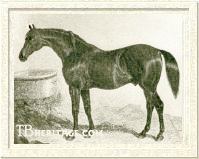
Muley
| |
MULEY (1810) was the well-bred son of Sir Charles Bunbury's Eleanor, by Whiskey, who went on the day after winning the Derby to win the Oaks easily. MULEY was Eleanor's best offspring, bred by Bunbury at his Great Barton estate in Suffolk. He inherited the muscular build of his sire, and had good bone, although his legs were, according to The Druid, "odd." He was a fair handicapper who could go a distance and best good winners. In 1815, he won a handicap at Newmarket Second Spring, beating 1812 St. Leger winner Otterington and ten other horses, and another handicap at Newmarket Houghton, in which he beat Emily (Emilius' dam) into second place. That year MULEY also ran second to dual Ascot Gold Cup winner Anticipation (by Hambletonian) in a plate at Newmarket Second October, beating the 1812 Doncaster Cup winner Slender Billy, and at the same meeting MULEY ran third in a sweep to Idle Boy and Cwrw.
|
MULEY was sold to William Harbord, Baron Suffield, who had estates in Norfolk and Lancashire, and was a big supporter of the Yarmouth race meetings. In 1826 he moved to Underley Hall, Kirkby Lonsdale, near the Yorkshire border, rebuilt by Alexander Nowell in 1825. MULEY sired a number of winners, most born at Underley, including Little Wonder (1837, out of Lacerta by Zodiac), who won the Derby; Vespa (1830, out of Miss Wasp by Waxy), who won the Oaks; and St. Leger winner Margrave (1829, from an Election mare). MULEY also sired the justly-named Leviathan (1823, from a Windle mare), a 16.3 hands tall, muscular, dark chestnut, unbeaten winner of nine races in succession at age three, and at age four winner of seven of his nine races. Leviathan was sold as a stallion to Lord Chesterfield, who stood him at stud for two seasons. James Jackson of Alabama had Weatherby's purchase him, and the horse was shipped to the U.S. in August of 1830, and placed in the care of Colonel George Elliott of Wall Spring,Tennesee, where he remained until his death in 1840. Leviathan was America's leading sire five times, the first whose offspring's winnings broke $100,000 in one year, getting a number of top four-mile runners and good producing daughters, but his long-term influence on bloodstock was hampered by the loss of many of his progeny in the Civil War.
MULEY'S most significant contributions to the breed, however, were his daughter, Marpessa (1830, from Clare by Marmion, Family 3 - n), and his son, Muley Moloch. Muley Moloch won eleven of his sixteen races over all distances. He got Doncaster's Park Hill Stakes winner Peggy, the dam of of 1859 Derby winner Musjid. More importantly, he got the great race mare, the "Queen of the Turf," Alice Hawthorn, in turn dam of Derby winner and leading sire, Thormanby, and of some daughters who were influential producers.
MULEY'S daughter Marpessa, who won the Nursery Stakes at Newmarket, produced Two Thousand Guineas winner Idas (1842, by Liverpool), but more importantly, was the dam of Pocahontas, one of the most influential horses in the General Stud Book. Pocahontas ran nine times, her best a second in a small race, but she produced three outstanding sons in succession, Stockwell ("the emperor of stallions"), Rataplan, and King Tom, and was the dam of other good winners and horses that bred on, as well. |
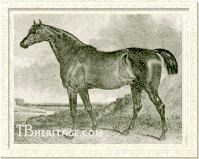
Richard, a good distance horse
| |
Orville's sons RICHARD (1818) and MASTER HENRY (1815) were both out of Miss Sophia, by Stamford, and bred by Mr. Elwes at Billing, Northamptonshire. The dark bay RICHARD was another big colt, 15.3 hands, with good bone and a strong, short back. He was sold to Lord Jersey, for whom he won one race at Newmarket as a three year old, and Jersey sold him to J.G. Lambton after his unsuccessful Derby attempt. At age four, his last season, he won the four mile King's Plate at Newcastle, the King's Plate at York, and, at the same York meeting, the four mile Great Subscription Purse. His other wins at four included a race in three mile heats at Pontefract, beating Byram, and the King's Plate at Doncaster, and he placed second to Incantator (by Sorcerer) at Newmarket in a race over Beacon Course, and second to Waverley (also owned by Lambton) in the Newcastle Cup. In the stud he got some good hunters.
|
|
MASTER HENRY was raced by Henry Pettitt and sold in 1821 to Lechemere Charlton, of Ludford Park, near Ludlow, Shropshire, who several years later purchased the good race horse Anticipation for a stallion at the then high price of 750 guineas, and would purchase and stand Pantaloon during the last five years of his life. MASTER HENRY was a good distance horse, especially in the mud. In 1820 he was second to Banker (later another Charlton stallion) in the Oatlands handicap at Newmarket Craven; in 1821 he won eight races, including the King's Puprse and a fifty at Newmarket, the Ludford Stakes, the Worcester Gold Cup and the Lichfield Gold Cup; the next year he took the Glocestershire Stakes at Cheltenham in 1822. His gift to the breed was his daughter Banter (1826, out of Boadicea, Family 14 - a), bred by Robert, (2nd) Earl Grosvenor. Banter won two races and then was retired to the Grosvenor stud, where, to the cover of Camel, she produced the great stayer and weight-carrier, Touchstone, who, like his great-grandsire, Orville, was exceptionally lazy. In the stud, Touchstone sired nine classic winners of twelve classic races and was leading sire four times in England, also getting Orlando and Newminster, themselves leading sires multiple times. Banter also produced Touchstone's St. Leger winning brother, Lancelot, and excellent producing daughters, including Jocose, dam of Derby winner and sire Macaroni, and Sarcasm, dam of St. Leger winner Satirist; both Macaroni and Satirist were by Pantaloon. |
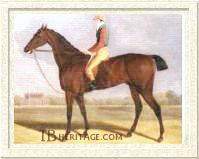
Doncaster Cup winner Fulford
| |
Other good running sons of Orville included Lord Darlington's BELVILLE (1811, from a Precipitate mare), who won the Oatlands at Ascot in 1817, beating seven good horses, and the Ascot Gold Cup in 1818, and BIZARRE (1820, from Bizarre by Peruvian) who won the Ascot Gold Cup, in 1824 and 1825, as well as the 1824 Oatlands at Ascot, Newmarket's Garden Stakes, and a match against Emilius at Newmarket in 1824. Colonel King's FULFORD (1812, out of Maniac, by Shuttle) ran third in Filho-da-Puta's St. Leger of 1815, and won the Doncaster Cup in 1917. |
Orville's son DINMONT (out of Mary, by Sir Peter) ran second in the 1815 St. Leger to Filho-da-Puta, and ran well in other northern races. FITZ ORVILLE (1814) won the Garden Stakes at Newmarket in 1818. GANYMEDE won Newmarket's Oatlands Stakes in 1823, and the Oatlands at Newmarket Craven in 1824. VARGAS won Newmarket's Craven Stakes in 1824.
Additional Orville sons who had some influence at stud included ANDREW (1816, out of Oaks winner Morel, by Sorcerer), who sired Cadland (1825). Cadland won the Two Thousand Guineas and the Derby, and was exported to France in 1834, where he became a highly influential sire of such horses as Nautilus, Britannia, Romulus, Essler, and Francesca. Cadland's son, The Prime Warden (1834), was also a good sire in France. Orville's son POLLIO (1823, out of Riddlesworth Stakes winner Blue Stockings, by Popinjay), got Oaks and Ascot Derby winner Pussy.
Orville's Daughters
Orville's daughters were not as good as his sons on the turf. He sired two One Thousand Guineas winners: CHARLOTTE (1811, from Sophia, by Buzzard), a half-sister to the dam of RICHARD and MASTER HENRY, and ZOE (1825, from Nina by Selim); Zoe also won the Underley Stakes at Newmarket Craven in 1828, beating a good field. ELIZABETH (1809, from Penny Trumpet by Trumpator) ran second to Manuella in the 1812 Oaks. Neither Charlotte nor Zoe did much in the stud, but Elizabeth produced a couple of good daughters from whom descended some good stakes winners in England, Europe, and South Africa (Family 11 - b).
|
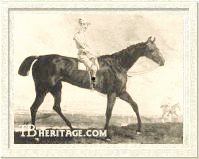
Souvenir
| |
SOUVENIR (1824) was Orville's best daughter on the turf. She was out of Dulcamara, the last foal Waxy ever sired, and was bred by Alexander Nowell of Underley, where Muley stood at stud. She ran for four seasons, and retired to Lord Sefton's stud, where she produced nine foals, the best of which was her 1835 colt, Young Tiresius. She was a small filly with great stamina.
As a juvenile, she debuted at Newmarket and ran second of three in a sweep for two year olds. Her only other race that season was at Swaffham, where she won a sweep for juveniles, beating three other youngsters.
|
At age three she started out a bit rocky, running last in a sweep won by Maresfield at Newmarket Craven, and then failed to place in Gulnare's Oaks race. Sent to Goodwood, she won the Drawing Room Stakes, beating Maresfield and five other youngsters. In the fall, she won the Garden Stakes at Newmarket Second October, beating Babel, Turcoman, and two others, and at the same meeting received a compromise from Chloris. At Newmarket Houghton she won a match for 100 sovereigns over the Ditch In course, beating Toso by three lengths, and at the same meeting won the Audley End Stakes, beating the future Oatlands winner Amphion, and four others.
In 1828, age four, she began with a walk-over for the King's Plate at Newmarket, and at the same meeting won a 200 sovereign match against Amphion. She (carrying 7 st. 13 lbs) ran second by a short head to Bobadilla (carrying 6 st 7 lbs) for the Ascot Gold Cup, beating five other good horses, including Brocard, Chateau Margeaux and Rapid Rhone; if Bobadilla's jockey had not thrown himself forward in the saddle just at the winning post, the race would have been declared a dead heat. At Bath she won a Silver Tureen, beating Windermere in a canter, but did not place in the Somersetshire Stakes. She was moved on to Brighton, where she ran second for the Gold Cup to Maresfield. At Goodwood she walked-over for the Goodwood Stakes, and at Newmarket First October received 100 sovereigns of a 200 sovereign match from Johnny. After this race, she was sold to Lord Sefton.
In her final season on the turf she won one race, the King's Plate at Newmarket First Spring, beating the 1828 Oaks winner Turquoise, and ran third in the Oatlands handicap at Newmarket Craven; she was beaten in a two mile match at Ascot against Maria, and lost the King's Plate at Ipswich to Lamplighter.
As producers, Orville daughters were fairly successful. He was dam's sire of three classic winners, and of several good sires. A number of his daughters are seen in direct tail-female descent of influential horses, albeit several generations removed.
MISS CRAIGIE (1811, from Marchionessa, by Weathercock), who ran second to Doctor Syntax in the three mile Middleham Cup in 1815, was the dam of 1830 St. Leger winner Birmingham, by Filho-da-Puta. LOUISA (1813, out of Thomasina, by Timothy, Family 15), was the dam of the Smolensko son, Jerry, who won the St. Leger in 1824. An unnamed brown ORVILLE MARE (1815, out of a Buzzard mare, Family 12 - g) was the dam of the in-bred Miss Letty (1834, by Priam), who won the Oaks, a race at York, and the King's Plate at Lincoln at age three, and in the stud produced the influential sire Weatherbit, who continued the Joe Andrews branch of the Eclipse sire line; the stallion Oxford, grandsire of the great Isonomy, descends in tail-female from Miss Letty, as do a number of good stakes winners.
DESDEMONA (1811, from Fanny, by Sir Peter, Family 5 - a) was another mare with stamina who ran in the north, running second to St. Leger winner Altisidora in a four mile race at Doncaster in 1815. She was bred and owned by Lord Fitzwilliam. She produced Doncaster Cup winner Mulatto, sire of Derby winner Bloomsbury and of Martha Lynn, the dam of dual classic winner and important sire Voltigeur. Desdemona's 1826 daughter Quadron was tail-female ancestress of a number of stakes winners.
An unnamed ORVILLE MARE (1812, Miss Grimstone, by Weazle, Family 21) was the dam of the Blacklock son, Tranby,
who won the Oatlands handicap at Newmarket Craven in 1832. Tranby was sent to the U.S., and, as grandsire (through a daughter) of Vandal and Virgil (sire of Hindoo), had an important influence on American bloodlines. This Orville daughter also was the dam of Wagtail (1818, by Prime Minister), who produced the great cup horse Laurel (by Blacklock), St. Leger winner Charles XII (by Voltaire), and good daughters, including Belinda, a sister to Laurel, who ran second in the St. Leger. Another daughter of this Orville mare, Miss Bowe (by Catton), was the dam of Oaks winner Iris and several other good runners.
Another unnamed ORVILLE MARE (1819, out of Epsom Lass by Sir Peter) produced the distance horse Slane (1833) to the cover of Royal Oak, a stallion that later became an important sire in France. At age four Slane was winner of the Dinner Stakes at Reigate, in which he beat Venison, Ascot's Swinley Stakes over 1-1/2 miles, the Somerset Stakes over 2/-14 miles at Bath, the Clocestershire Stakes at Cheltenham, a Queen's Plate at Winchester, the Waterloo Shield over the Queen's Plate Course (3-3/4 miles) at Goodwood; the Cup at Oxford, over two miles, and he also ran second to Touchstone in the Ascot Gold Cup. Slane led the sire's list in England in 1845; his offspring included Derby winner The Merry Monarch, Two Thousand Guineas winner Conyngham, Oaks winner The Princess, and One Thousand Guineas winner Lady Orford.
The brown AGATHA (1814, out of a mare by Star, Family 23 - a) was another good running filly of Orville's, who ran second to Blacklock in York's Great Subscription Purse (over 2 miles). She produced the filly Frailty, by Filho-da-Puta, who was the dam of Oaks winner Cyprian and tail-female ancestress of a number of good stakes winners. Many Orville daughters, like Agatha, were second or third dams of influential animals, and can be seen in stakes winners' pedigrees throughout the world.
--Patricia Erigero
|
|
|
|

